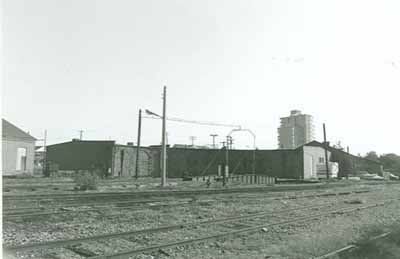Esquimalt and Nanaimo Railway Roundhouse National Historic Site of Canada
Victoria, British Columbia

General view
(© Parks Canada Agency/ Agence Parcs Canada, Mills Photo No. 2, 1991.)
Address :
251-253 Esquimalt Road, Victoria, British Columbia
Recognition Statute:
Historic Sites and Monuments Act (R.S.C., 1985, c. H-4)
Designation Date:
1992-06-04
Dates:
-
1912 to 1913
(Construction)
-
1912 to 2007
(Significant)
Event, Person, Organization:
-
R.A. Bainbridge, CPR division engineer, Victoria
(Architect)
-
E.R. Doe & Brother
(Builder)
Other Name(s):
-
Esquimalt and Nanaimo Railway Roundhouse
(Designation Name)
Research Report Number:
1992-SUA Feb, 2004-085
Plaque(s)
Existing plaque: 251-253 Esquimalt Road, Victoria, British Columbia
This imposing brick roundhouse is a particularly fine example of an industrial structure associated with the steam railway era in Canada. Built in 1913, the ten-stall roundhouse with attached machine, boiler and blacksmith's shops is part of a remarkably well-preserved railway yard that also includes a car shop and stores building. The roundhouse complex served the Esquimalt and Nanaimo Railway long after the introduction of the diesel locomotive in 1949 and the railway's operational relocation to Nanaimo in the 1950s. This site is an important reminder of Canada's rich railway heritage.
Approved 1999
Description of Historic Place
Designed in 1912 and completed in October 1913, the Esquimalt and Nanaimo Railway Roundhouse is located in Victoria, British Columbia. The site is comprised of three sections: the locomotive roundhouse and two attached structures that housed various shop facilities for the servicing of steam locomotives. The roundhouse building was built to a segmental-arced plan and features a curved front and rear wall constructed of solid red brick. It contains ten stalls that face onto an operational turntable with an 85-foot diameter. The machine shop is a rectangular brick building that abuts the rear southeast corner of the roundhouse. The roundhouse complex is surrounded by associated site features, notably the turntable, sidings and tracks, and two freestanding brick buildings which are components of the industrial complex and are contemporary to the roundhouse. The official recognition refers to the area enclosing the 10-stall roundhouse building with attached machine shop, both on their footprints, and the detached turntable in its circular pit. This area also includes approach tracks. The space between the main building and the turntable is also part of the designated place.
Heritage Value
The Esquimalt and Nanaimo Railway roundhouse was designated a national historic site of Canada in 1992 because it survives virtually untouched since its construction in 1912. Surrounded by various well-preserved related shops and railway outbuildings, it is a particularly fine example of an industrial structure associated with the steam railway era in Canada.
The Esquimalt and Nanaimo roundhouse is located on the site of the original 1886 railway terminus for Victoria. This industrial complex was built by the Canadian Pacific Railway to serve as the primary servicing facility for the steam locomotives and rolling stock of the Esquimalt and Nanaimo Railway. The facility served this purpose until 1949 when steam locomotives were replaced by diesels on the island. After that date the roundhouse served as a service facility for the E & N’s diesels, and currently services the passenger dayliners used by the railway. Remarkably, the roundhouse and contemporary shops have survived with minimal alterations since the time of their construction.
The roundhouse complex, consisting of the roundhouse itself, the attached machine shed, the roundtable and the approach tracks, conveys a clear sense of its functional purpose in its structure and organizational layout. The roundhouse itself curves around the turntable and features ten large openings creating ten work bays for the repair of the locomotives. The large windows at the rear of the building provided natural light into each of the 10 work bays. The machine shop is attached to the rear of the roundhouse and cars could be moved into the building through the roundhouse or by a separate track leading off the turntable. The machine shop is divided internally into two sections by a brick partition wall. The rear area was built to house a blacksmith shop and boiler shop.
A distinct sense of place is conveyed by the uniformity of materials, fenestration, building configuration, and by presence of the turntable that links the entire complex of buildings into an efficient industrial plant. The Esquimalt and Nanaimo roundhouse complex is the most intact facility associated with the servicing of steam locomotives in western Canada.
Source: The Historic Sites and Monuments Board of Canada, Minute, February 1992.
Character-Defining Elements
The key elements relating to the heritage value of this site include: the site in the Songhees area of Victoria West, across the Inner Harbour from downtown Victoria; the historical relationship between the roundhouse facility and Victoria as embodied in the track corridor linking the site to the downtown terminus via the Johnson Street bridge; the site in its defined boundaries and its continuous association with the Esquimalt and Nanaimo Railway from the railway’s inception in 1886 to the present day; the form, massing and exterior design features of the roundhouse including the segmental floor plan, spatial organization in relation to the turntable, solid brick construction, large windows and door placements and surrounds; the large open bays of the roundhouse with their the original wooden doors and associated hardware and surround details; interior structural elements of the roundhouse including the roof truss system, timber supports, and original wall surfaces; roof details and mechanical elements including smoke jacks, ventilators and skylights; the form massing and exterior design features of the machine shop including the rectangular plan divided into two areas separated by a brick wall, large segmental windows, round-headed locomotive entrance, engaged brick piers, and gabled roof; railway tracks within the buildings, on the turntable and leading up to the building; vestiges of industrial equipment including the floor pits and aprons, the steel turntable, concrete-walled turntable pit, and associated tracks and machinery.